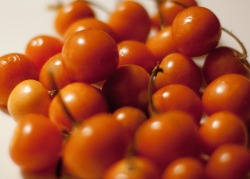 Superfoods, aji peppers, pichuberries, goji berries, purple corn, green tea, ancient seeds, Mediterranean foods, Peruvian cuisine, Korean tacos, the list of trendy food flavors and themes go on and on. Add that to the list of consumer trend behaviors around food, like cravings for sweet & savory, wellness foods, “adventure, courage & optimism,” quest for authenticity, internationalism on the agenda, etc. Mining food trends and identifying which are the most opportunistic can be a daunting task for food producers, retailers and foodservice establishments, including restaurant companies.
Superfoods, aji peppers, pichuberries, goji berries, purple corn, green tea, ancient seeds, Mediterranean foods, Peruvian cuisine, Korean tacos, the list of trendy food flavors and themes go on and on. Add that to the list of consumer trend behaviors around food, like cravings for sweet & savory, wellness foods, “adventure, courage & optimism,” quest for authenticity, internationalism on the agenda, etc. Mining food trends and identifying which are the most opportunistic can be a daunting task for food producers, retailers and foodservice establishments, including restaurant companies.
Understanding what is “hot” is easy; diving into a cross-analysis against market data and significant consumer opinions is more complex. The task of identifying today's most opportunistic food trends can be made easier by cross-analyzing against these factors. Food industry players are wise to make data-driven decisions and not just produce to today’s flavor of the day. Here’s a way to start:
Seek first to understand the food context and conversation
First, identify the context of your needs and how they fit into the stage of food trends. For instance, manufacturers need a longer lead time to produce products from emerging foods, but have significant investments to make to launch new products for consumers and large groups of foodservice customers. Companies of this type are often well-served by looking at what we call “penetrated foods,” foods and food & beverage ingredients that are already part of media and culinary conversations and have established a consumer-driven need. Upscale restaurants and chefs are in a continual experimentation and discovery cycle, so “emerging foods” are their frameworks for research, while quick-service chains might be best served by “integrated” foods.
Listening to media mentions, food and trade publications, cable and streaming food shows is a start. Those mentions then need to be vetted against product manifestations – what is out there and who is experimenting and serving that food. Establishing need and context is a good foundation to look at food trends.
Do you want to spot or vet?

If you’re always food-spotting, will you serve menu products that are a hit? Will you create new beverages that become ubiquitous?
Vetting food trends is what creates an opportunity-scape for companies. Food-spotting is at the initial stage of this process. R&D/product development, insight, brand management, marketing and consumer insight specialists often use market data, consumer surveys, social context and analogous products to identify what is most opportunistic from a food development, retailing or foodservice perspective.
For instance, purple corn, which has been expanding on restaurant menus recently outside of international cuisine-themed eateries, is already being used in the production of juices. And, there are new consumer drivers that are prompting its use. There are tortilla chips being produced within the non-GMO market. On the other hand, Quinoa, an ancient seed mainly exported by Peru and Brazil currently, has been around for a very long time, but it has become a modern gem in product development across many product categories, including breakfast cereals, nutritional drinks and sides. Looking ahead, there will be much more quinoa exploration, although some wrote the seed off (or started hating it) several years ago. Thus, restaurants aren’t always on the front lines of food exploration, and food producers are weary of looking at linear forms of food research to understand what they need to act upon.
That’s why successful food industry researchers and stakeholders rely on trend vetting that integrates a data-driven approach. Definitely look at getting access to tools and reports that capture data within the current marketplace tabulating sales and the success of products and ingredients similar to what you are researching.
The Culinary Trend Tracking Series, launching on March 25, 2014 by Packaged Facts, looks at key global foods and food & beverage ingredients that are potentially lucrative for the food and beverage industry. Such a series has relied on in-house survey analysis, cross-referencing of market product sales and partnered with experts to access menu and product-level insights.
Partner with those who understand the marketplace
For success in the food marketplace, partner with someone who understands consumer insight and the marketplace. Is the gluten-free market bubbling or bursting? Is GMO concern exploding or over-blown? Is there a future for the amaranth seed? Getting the perspective from experts, whether consultative or through their reports, is another sound strategy for success. A few reasons for this:
- Being on the inside often doesn’t let you see the marketplace in a comprehensive format. Receiving perspective from others who have no company-specific interest in your products and are experts in the analysis of the industry is empowering.
- Quickly increasing opportunity-creation development and tactics means streamlining research, which will allow more time for the development life cycle.
- Streamlining research also means enabling the re-allocation of money and resources to the successful marketing of products, potentially tallying higher return on investment.
To learn more about how trend tracking can help your business identify new opportunities, download our free white paper.
Thanks for reading!
Rick Zambrano
Food Research Editor,
Packaged Facts
Rick Zambrano is a food research editor for Packaged Facts, publisher of the Culinary Trend Tracking Series. Packaged Facts introduced its new culinary research report series with South American Flavors report in March.
Photo credit: All images courtesy of Mojo Tree Farm.


